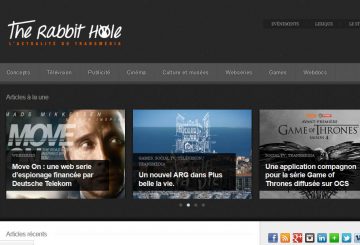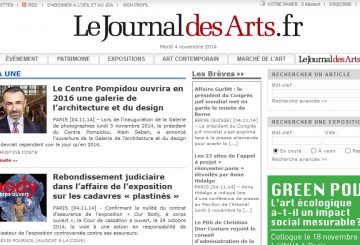Again on Thursday, new portrait and this time a professional live performance! Because yes, Culture also includes live performance, little is known about the subjects combining digital and cultural mediation. Anne Le Gall, Head of Communications at the Théâtre du Rond-Point, [ie Anne is now director of the Culture and Development in the Avant-Seine Colombes theatre ] so we will try to understand what to do theater an object of transmission.
You are in our fifth installment of our series “New Practices and Culture, a small tour professionals” and here is the result of programmes!
Introduction:
– The Department News writings of France Television has partnered with the Theatre du Rond-Point on the occasion of the creation of Theatre without animals in January 2013 by imagining a device theatre enriched, expanded version of the piece.
– Arrival in 2005 in the service of communication, Anne Le Gall, head of communications, trying to integrate the use of social networks in the theatre and with the public.
What definition of Théâtre du Rond-Point on the internet?
The theatre wanted to create a “universe Roundabout”, that is to say an ecosystem with programming (via WebTV Dailymotion founded in 2008 -date partnership signed with Dailymotion- website and the online journal Ventscontraires. net launched in 2010), as an extension of the field of theatre and a community (Facebook and Twitter mainly) involving actual and potential public audience, interested in a certain state of mind.
This universe is intrinsically tied to the news of the theatre but has a view that does not want to “promotional” we create around these channels dedicated to entertainment content, their themes, welcomed and familiar du Rond-Point artists, mind programming and place, the famous “Laughing Resistance.” We occasionally broadcast live events on Dailymotion, regularly PodCast and video on our online magazine.
This allows us to reach a wider target, while maintaining a special relationship with the surfers. The tone of the tweets wants voluntarily live and non-institutional and take advantage of this medium to reach more particularly journalists, many on this network, and bloggers, culture and digital. Moreover, we have experienced three times the live-tweet on this social network, the last time at the launch of our 13/14 season.
We select the tools and networks that seem suited to our needs and uses, but also to test some tools, following the innovations and digital trends: for example, we quickly opened a Google Plus account, but finally we use little; for image work we did not engulfed in Pinterest but we use Instagram and GifBoom or we have recently created a Tumblr. Of informative through the dissemination and uptake “stolen moments”, each network offers complementary angles to attract different audiences and enriching our speech. This is the end to put the content in the heart of our digital strategy.
The Theatre du Rond-Point has an “augmented” Theatre without animals release. What is this and what are the expectations?
Theatre without animals is one of the most played in France by professional and amateur companies parts. The text is also a frequent teaching aid. Therefore, it is a play on a broad public and shape in short scenes, making it suitable for a digital broadcast material. It naturally lent itself to this project initiated and funded by the New Scriptures France Television.
It is a real laboratory, also won an Audience Award at the Smart SIPA. This is -because the project is still online- experiment how the web can truly enrich a theatrical release. Simple diffusion theater video has always been problematic, switching to video lost the essential character of the experience of living, the experience of “being a spectator.” There are some great recordings, of course, but this limit is still tangible. Digital brings a further layer interactivity, enrichment, handling direct by the user. It is no longer quite “look of the theater” is a whole new experience. And experience can become a carrier mediation with audiences including school as was discussed with teachers.
On the other hand, a cabin (device fully owned project) was installed in the lobby to access the in situ experiment. The success of videomaton is relative: for now the public needs to be guided to use it; ergonomics and ideal formula has not yet been found. But it is an interesting avenue for us, performing arts professionals. For the question of in situ digital is at the heart of discussions. How, like museums, can we bring in the concept of digital theaters mediation? Not only mediate on the web but mediation on site using digital tools. We experimented with live-tweet with this device. We work to imagine the rest.
This goes back to the fundamental issue of the design of a digital strategy: digital is not that the “virtual” there is no opposition between the ‘real’ public and virtual users, the spirit programming and the spirit of our web universe … A digital strategy, at least for a cultural institution, has set out to build our brand image but also back to the ground and mediation. It seems to me all important cases.
The device Theatre theater enriched with no animals on this form is a “one shot” not the beginning of a series for the New Scriptures. By cons, its lifetime is long it will stay online, we will communicate it again on the occasion of the revival of the show in late 2013 and we’ll see what uses will naturally users. Such a project can not otherwise be carried by a single institution: it’s a full production, which is not our vocation and certainly not in our budget. However, this example can we (communication professionals performing arts) to draw out more specific things, especially for the in situ portion. Run virtual auditions for spectators, it was fun and it was discovered the text. This is a track among many.
 Why so little use of digital technology in the structures of the performing arts?
Why so little use of digital technology in the structures of the performing arts?
I think there are several reasons for this state. I set aside the use of digital otherwise than as a working tool (database, weblogiciel, collaborative tools) and information (corporate website, newsletter). This already is not always won.
First the history. I often compare our industry to the museum where innovation in communication and digital mediation is much more present. In museums, the issue of media landmark CD-ROM tour of exposure of 90 years to digitize collections, audio guides, open data, until the constitution of the sparkling community museogeek today ‘hui. Digital, especially as work tools and mediation is in place for a long time. Walking is not as high and the fiscal pressure: the digital mediation, at least in large institutions, its line of funding, its multimedia service and potential project managers trained in these matters.
In addition, the museum experience itself, unlike the theatrical experience, be invested by a layer of digital mediation. This enriched experience, complete theater when it interrupts, disturbs. This can only be done if the artist incorporates this layer to the show, which has been in shows improvisational theater, concerts (one artist had designed a smartphone application that reacted to his music, the audience installing it before entering the room) … But it was not intended to be universal. Theaters have tried, this is the hot topic, invite their audience to twitter live during the performances, with the creation of tweet-seats as we have seen in the United States. Even they, singers and cultural digital marketing in return in terms of live performance. This does not work, we miss his viewing experience.
Finally, the digital capture (scanning the theater) and online distribution? Why not. ARTE LiveWeb (now ARTE Concert) done some great things, Dailymotion and YouTube broadcast operas, events. But it must be worn, or at least co-produced by a diffuser. Places, such as companies, can not, for all shows, fund an embodiment of quality and the rights and miscellaneous. If we really wanted to do this work the scene capture and dissemination should be a dedicated funding. One moment, was referred to the creation of a virtual theater, a device in public funding … but I do not know where it is.
The use of digital technology for mediation and communication within the institutions of the performing arts is to invent, again and again, the strength of the wrist and through individual wills, in-house or through collaborations between structures. But it takes time, energy and a strong will! Attitudes are changing slowly, and interest is growing. I try to observe what is happening everywhere, but it’s hard to know all the initiatives in this area. I regularly meet with other professionals to exchange places often very rich. I cherish the dream of building a community of theatrogeek, we are already a few members in this informal group and unofficial. In any case, this part of our work is a great source of emulation and creativity.
Meanwhile, Anne Le Gall works, such an impressionist with his colleagues every day, bit by bit, to get some ideas, learn some tools to understand the value of such networks … In short, there is also a pedagogical work and “evangelization” lengthy but absolutely necessary to keep the performing arts professionals in a dynamic and creativity in public service that is not on the side of the artists.
Some links …
– Théâtre du Rond-Point website
– Théâtre sans animaux website by New writings by de France Télévision
– Ventscontraires.net web-revue of Théâtre du Rond-Point
– social networks:
-Anne Le Gall websites:
- The Pink One :
- Blog : Geekeries culturelles et prospectives
- Twitter : @AnneLeGall
[translation by Google translate]






You must be logged in to post a comment.